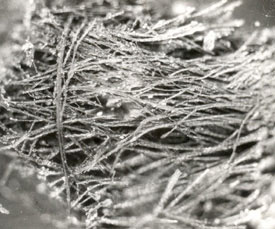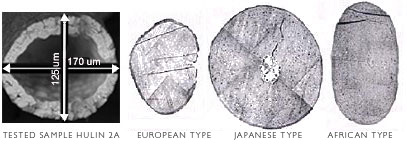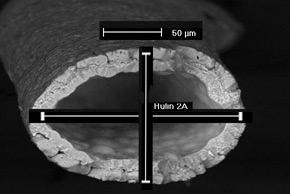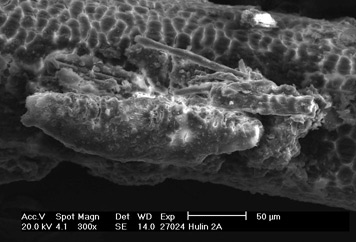EXAMPLE OF UNKNOWN SKIN SAMPLE IDENTIFICATION BY FURSKIN PROGRAM
 In 1979, during an archeological research, Professor V. Hruby found a sample of fur skin in grave No 226/51 at field called "Na Valach" near UH Hradiste city. The sample was part of a fur article, probably muff, situated on the belly area of a girl skeleton inserted in a wooden coffin reinforced by six iron belts. There were small pieces of dress, the fur skin, two silver cluster earrings, and one stripped glass bead. The grave was dated to the ninth century.
COMPARISON OF DATA
For identification by the FURSKIN program, the sample was micro-graphically documented by scanning electron microscope Joel 35. Some of the figures are shown below. The following data were entered into the computer:
Surface of the skin: |
3.0-1.0-3.0 |
Fine fibers: |
7.0-1.0-1.0-2.0-0.1-0.1-0.1-4.0-0.0-10.22-7.15 |
Intermediate fibers: |
2.0-1.0-1.0-1.0-1.0-0.0-0.0-0.0-0.0-30.50-20.22 |
Guard hairs: |
2.0-1.0-2.0-1.0-1.0-1.0-1.0-3.0-1.0-80.100-20.25 |
Data responding to individual structural pattern were entered; zero is used when a feature could not be determined.
RESULT OF NUMERICAL COMPARISON
On the base of the used data, the program displayed a collection of animal species together with a score number of differences. The reliability of the results increase with the number of identified structural patterns. The best score (30) was found for Lutra lutra species. In descending collection on the second place were Giraffa camelopardalis and Enhydra lutris (both with the score 36). All others species have greater score values.
VISUAL COMPARISON
The second step in identification was visual comparison of the sample microscopic figures with figures belonging to lutra species in digitalized atlas. This confirmed the result. Figures are shown later.
RESULT
The unknown sample belongs to Lutra lutra species with high level of probability.
|
 |
EVALUATION OF MICROSCOPICAL ARTIFACT OF ARCHAEOLOGICAL FOUND IN HULIN 2005
COULD BE FOUND HAIRS OF HUMAN ORIGIN?
The thickness of found hairs is similar to the human hairs. The difference is in their cross-section and thickness of medulla. Relatively frequent variation of human hairs is often categorized into three groups (see picture). European type has an irregular oval cross-section; people with straight hairs usually have a bigger size in diameter than the sample. The marked oval cross-section is usually the reason of native curly hairs because alpha and beta cortex are spiral alternated. Although the cross-section is similar to the Asian type of human hairs, they are significantly different in the diameter of medulla which occupies mostly the whole hair. The medulla in the sample of unknown hair has just a few percent or is totally missing. The found hairs, after comparison with three human hair types, are not obviously human.

ASSIGNMENT OF ANIMAL SPECIES, USED METHOD
For assignment of animal species the Fur Skin Microscopic Atlas, published by Elsevier (Amsterodam, Oxford, New York, Tokyo 1989) modified by A. Galatik for computer, was used. The program for unknown fur skin identification evaluates the morphological characteristic of the photo of the tested sample and compares it with the data set of 134 mammals. There are 36 morphological patterns represented by a number for every animal. This number of patterns allows quite accurate identification of animal species. The initial three patterns describe the structure of skin surface. It is suitable to have a sample of fur skin for their assignment. The next 11 parameters describe fine fur fibers (they have usually the shortest length), 11 parameters of the intermediate hairs and 11 features of the guard hairs. Characteristic of all types of hairs includes shape and typology of three layers of hair: Scales skin (Cuticle), rind (Cortex), and a porous centre (Medulla). The program offers pictures of all possibilities for easier selection of each feature. In this case, we have mainly photos of guard hairs made by scanning electron microscopy. There was one fine fur fiber and a couple of intermediate hairs in one photo. From this reason we could use about 60% of the features. It is sufficient for evidential animal species identification. The program produces a list of animals with their difference number sorted from the most probable to the less probable.
Photos obtained by scanning electron microscopy make it possible to define the numeric parameters for comparison with the data set animals in the atlas.
DENTIFICATION OF FUR SKIN
Numeric value of parameters which are not available is 0. Codes of morphological features are entered according to the offered type photos of skin surface, hair follicles, cuticular scales, the structure of the cortex, and medulla. The thickness of the fine fur is 6µm, intermediate hair 10µm and guard hair 120µm was read from photos.


(Photographed by Martin Hlozek)
Surface of the skin: |
0.0-0.0-0.0 (Nelze z analyzovaného vzorku určit) |
Fine fibers: |
1.0-1.0-1.0-1.0-2.0-1.0-1.0-8.0-3.0-6.6-0.0 |
Intermediate fibers: |
1.0-1.0-1.0-1.0-2.0-1.0-1.0-8.0-3.0-10.10-0.0 |
Guard hairs: |
1.0-1.0-1.0-1.0-2.0-1.0-1.0-8.0-3.0-120.120-0.0 |
RESULT OF COMPARISON
1. Equus przewalskii (Przewalski horse (wild horse)) 29 differences
2. Kolonocus sibiricus (Siberian weasel, kolinski) 31 differences
3. Alopex lagopus (White fox) 33 differences
4. Capra sibirica (Siberian ibex) 33 differences
5. Arvicola terrestris (Water vole) 34 differences
6. Galago senegalensis (Senegal bush baby) 35 differences
7. Allactaga major (Allactaga major) 35 differences
8. Otaria byronia (South American sea-lion) 35 differences
9. Tupaia glis (Tree shrew) 35 differences
10. Apodemus sylvaticus (Wood mouse) 36 differences
CONCLUSION
The results of the comparison indicate that the hairs are of wild horse origin. The age of the archaeological found in Hulin 2005 is dated 2000 years BC. It is possible that the ancient form of wild horse was tamed 4000 years ago and used in our region.
|
|
 In 1979, during an archeological research, Professor V. Hruby found a sample of fur skin in grave No 226/51 at field called "Na Valach" near UH Hradiste city. The sample was part of a fur article, probably muff, situated on the belly area of a girl skeleton inserted in a wooden coffin reinforced by six iron belts. There were small pieces of dress, the fur skin, two silver cluster earrings, and one stripped glass bead. The grave was dated to the ninth century.
In 1979, during an archeological research, Professor V. Hruby found a sample of fur skin in grave No 226/51 at field called "Na Valach" near UH Hradiste city. The sample was part of a fur article, probably muff, situated on the belly area of a girl skeleton inserted in a wooden coffin reinforced by six iron belts. There were small pieces of dress, the fur skin, two silver cluster earrings, and one stripped glass bead. The grave was dated to the ninth century.